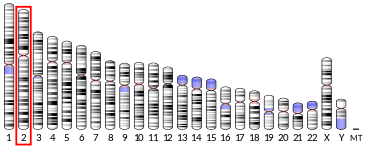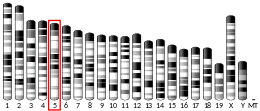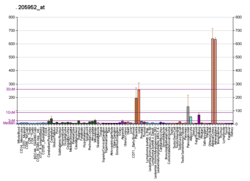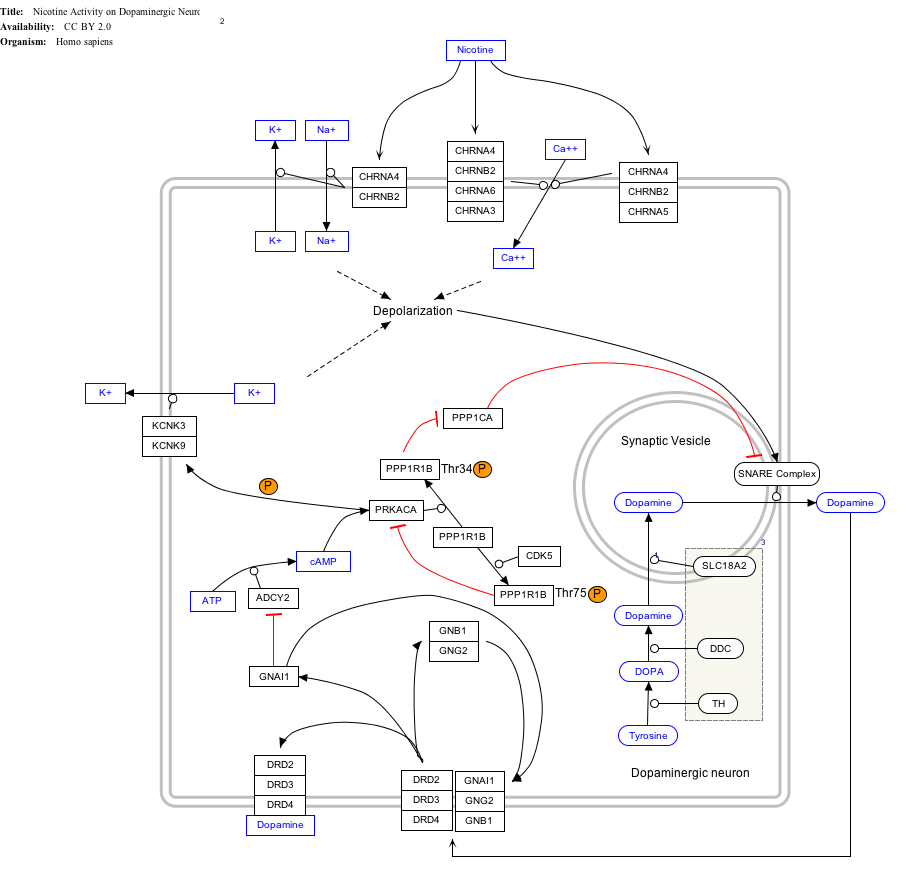KCNK3
Potassium channel subfamily K member 3 is a protein that in humans is encoded by the KCNK3 gene.[5][6][7][8]
This gene encodes K2P3.1, one of the members of the superfamily of potassium channel proteins containing two pore-forming P domains. K2P3.1 is an outwardly rectifying channel that is sensitive to changes in extracellular pH and is inhibited by extracellular acidification. Also referred to as an acid-sensitive potassium channel, it is activated by the anesthetics halothane and isoflurane. Although three transcripts are detected in northern blots, there is currently no sequence available to confirm transcript variants for this gene.[8]
Interactive pathway map
Click on genes, proteins and metabolites below to link to respective articles.[§ 1]
- The interactive pathway map can be edited at WikiPathways: "NicotineDopaminergic_WP1602".
Interactions
KCNK3 has been shown to interact with YWHAB[9] and S100A10.[10]
See also
- Tandem pore domain potassium channel
References
- GRCh38: Ensembl release 89: ENSG00000171303 - Ensembl, May 2017
- GRCm38: Ensembl release 89: ENSMUSG00000049265 - Ensembl, May 2017
- "Human PubMed Reference:". National Center for Biotechnology Information, U.S. National Library of Medicine.
- "Mouse PubMed Reference:". National Center for Biotechnology Information, U.S. National Library of Medicine.
- Duprat F, Lesage F, Fink M, Reyes R, Heurteaux C, Lazdunski M (Dec 1997). "TASK, a human background K+ channel to sense external pH variations near physiological pH". EMBO J. 16 (17): 5464–71. doi:10.1093/emboj/16.17.5464. PMC 1170177. PMID 9312005.
- Lesage F, Lazdunski M (Oct 1998). "Mapping of human potassium channel genes TREK-1 (KCNK2) and TASK (KCNK3) to chromosomes 1q41 and 2p23". Genomics. 51 (3): 478–9. doi:10.1006/geno.1998.5397. PMID 9721223.
- Goldstein SA, Bayliss DA, Kim D, Lesage F, Plant LD, Rajan S (Dec 2005). "International Union of Pharmacology. LV. Nomenclature and molecular relationships of two-P potassium channels". Pharmacol Rev. 57 (4): 527–40. doi:10.1124/pr.57.4.12. PMID 16382106.
- "Entrez Gene: KCNK3 potassium channel, subfamily K, member 3".
- O'Kelly, Ita; Butler Margaret H; Zilberberg Noam; Goldstein Steve A N (Nov 2002). "Forward transport. 14-3-3 binding overcomes retention in endoplasmic reticulum by dibasic signals". Cell. United States. 111 (4): 577–88. doi:10.1016/S0092-8674(02)01040-1. ISSN 0092-8674. PMID 12437930.
- Girard, Christophe; Tinel Norbert; Terrenoire Cécile; Romey Georges; Lazdunski Michel; Borsotto Marc (Sep 2002). "p11, an annexin II subunit, an auxiliary protein associated with the background K+ channel, TASK-1". EMBO J. England. 21 (17): 4439–48. doi:10.1093/emboj/cdf469. ISSN 0261-4189. PMC 125412. PMID 12198146.
Further reading
- Goldstein SA, Bockenhauer D, O'Kelly I, Zilberberg N (2001). "Potassium leak channels and the KCNK family of two-P-domain subunits". Nat. Rev. Neurosci. 2 (3): 175–84. doi:10.1038/35058574. PMID 11256078.
- Patel AJ, Honoré E, Lesage F, et al. (1999). "Inhalational anesthetics activate two-pore-domain background K+ channels". Nat. Neurosci. 2 (5): 422–6. doi:10.1038/8084. PMID 10321245.
- Manjunath NA, Bray-Ward P, Goldstein SA, Gallagher PG (2000). "Assignment of the 2P domain, acid-sensitive potassium channel OAT1 gene KCNK3 to human chromosome bands 2p24.1→p23.3 and murine 5B by in situ hybridization". Cytogenet. Cell Genet. 86 (3–4): 242–3. doi:10.1159/000015349. PMID 10575216.
- Lopes CM, Gallagher PG, Buck ME, et al. (2000). "Proton block and voltage gating are potassium-dependent in the cardiac leak channel Kcnk3". J. Biol. Chem. 275 (22): 16969–78. doi:10.1074/jbc.M001948200. PMID 10748056.
- Ashmole I, Goodwin PA, Stanfield PR (2002). "TASK-5, a novel member of the tandem pore K+ channel family". Pflügers Arch. 442 (6): 828–33. doi:10.1007/s004240100620. PMID 11680614.
- Talley EM, Bayliss DA (2002). "Modulation of TASK-1 (Kcnk3) and TASK-3 (Kcnk9) potassium channels: volatile anesthetics and neurotransmitters share a molecular site of action". J. Biol. Chem. 277 (20): 17733–42. doi:10.1074/jbc.M200502200. PMID 11886861.
- Buist SC, Cherrington NJ, Choudhuri S, et al. (2002). "Gender-specific and developmental influences on the expression of rat organic anion transporters". J. Pharmacol. Exp. Ther. 301 (1): 145–51. doi:10.1124/jpet.301.1.145. PMID 11907168.
- Barbuti A, Ishii S, Shimizu T, et al. (2002). "Block of the background K(+) channel TASK-1 contributes to arrhythmogenic effects of platelet-activating factor". Am. J. Physiol. Heart Circ. Physiol. 282 (6): H2024–30. doi:10.1152/ajpheart.00956.2001. PMID 12003807.
- Girard C, Tinel N, Terrenoire C, et al. (2002). "p11, an annexin II subunit, an auxiliary protein associated with the background K+ channel, TASK-1". EMBO J. 21 (17): 4439–48. doi:10.1093/emboj/cdf469. PMC 125412. PMID 12198146.
- O'Kelly I, Butler MH, Zilberberg N, Goldstein SA (2002). "Forward transport. 14-3-3 binding overcomes retention in endoplasmic reticulum by dibasic signals". Cell. 111 (4): 577–88. doi:10.1016/S0092-8674(02)01040-1. PMID 12437930.
- Aslamkhan A, Han YH, Walden R, et al. (2003). "Stoichiometry of organic anion/dicarboxylate exchange in membrane vesicles from rat renal cortex and hOAT1-expressing cells". Am. J. Physiol. Renal Physiol. 285 (4): F775–83. doi:10.1152/ajprenal.00140.2003. PMID 12837685.
- Strebel K (2004). "HIV-1 Vpu: putting a channel to the TASK". Mol. Cell. 14 (2): 150–2. doi:10.1016/S1097-2765(04)00205-9. PMID 15099514.
- Hsu K, Seharaseyon J, Dong P, et al. (2004). "Mutual functional destruction of HIV-1 Vpu and host TASK-1 channel". Mol. Cell. 14 (2): 259–67. doi:10.1016/S1097-2765(04)00183-2. PMID 15099524.
- Rusznák Z, Pocsai K, Kovács I, et al. (2004). "Differential distribution of TASK-1, TASK-2 and TASK-3 immunoreactivities in the rat and human cerebellum". Cell. Mol. Life Sci. 61 (12): 1532–42. doi:10.1007/s00018-004-4082-3. PMID 15197476.
- Bai X, Greenwood SL, Glazier JD, et al. (2005). "Localization of TASK and TREK, two-pore domain K+ channels, in human cytotrophoblast cells". J. Soc. Gynecol. Investig. 12 (2): 77–83. doi:10.1016/j.jsgi.2004.08.004. PMID 15695101.
External links
- KCNK3+protein,+human at the US National Library of Medicine Medical Subject Headings (MeSH)
This article incorporates text from the United States National Library of Medicine, which is in the public domain.





